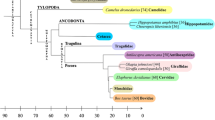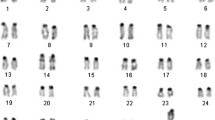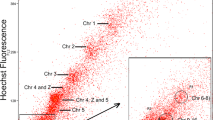Abstract
We used chromosome painting with chromosome-specific probes derived from domestic sheep and pig for a high-resolution cytogenetic comparison with the karyotype of collared peccary (Pecari tajacu sonoriensis). A reorganization of the karyotype involving at least 62–66 conserved segments were observed between the sheep and collared peccary. This is an extremely high number compared with other members of the same mammalian order (Cetartiodactyla). The comparison between pig and collared peccary, both belonging to the Suiformes, however, revealed various changes in the gross organization of both karyotypes that may have already occurred in a common ancestor of both species suggesting a monophyletic origin of Suidae/Tayassuidae. The sheep probes, however, also revealed several rearrangements between the two Suidae/Tayassuidae, indicating that these probes represent a useful tool for a more detailed analysis of the evolutionary history of Suiformes. Our sample of the collared peccary from North America (Arizona, USA) showed distinct differences to those already described from South America. The chromosome painting results defined a complex translocation that involves chromosomes including about one-quarter of the entire collared peccary karyotype. This considerable rearrangement indicates subspecies or even species status of both peccary populations, as it should present a significant barrier for their hybridization.
Similar content being viewed by others
References
Bielec PE, Gallagher DS, Womack JE, Busbee DL (1998) Homologies between human and dolphin chromosomes detected by heterologous chromosome painting. Cytogenet Cell Genet 81: 18–25.
Biltueva LS, Yang F, Vorobieva NV, Graphodatsky AS (2004) Comparative map between the domestic pig and dog. Mamm Genome 15: 809–818.
Bosma AA, de Haan NA, Arkesteijn GJ, Yang F, Yerle M, Zijlstra C (2004) Comparative chromosome painting between the domestic pig (Sus scrofa) and two species of peccary, the collared peccary (Tayassu tajacu) and the white-lipped peccary (T. pecari): a phylogenetic perspective. Cytogenet Genome Res 105: 115–121.
Chowdhary BP, Raudsepp T, Fronicke L, Scherthan H (1998) Emerging patterns of comparative genome organization in some mammalian species as revealed by Zoo-FISH. Genome Res 8: 577–589.
Consigliere S, Stanyon R, Koehler U, Agoramoorthy G, Wienberg J (1996) Chromosome painting defines genomic rearrangements between red howler monkey subspecies. Chromosome Res 4: 264–270.
Fauth C, Speicher MR (2001) Classifying by colors: FISH-based genome analysis. Cytogenet Cell Genet 93: 1–10.
Froenicke L (2005) Origins of primate chromosomes–as delineated by Zoo-FISH and alignments of human and mouse draft genome sequences. Cytogenet Genome Res 108: 122–138.
Froenicke L, Wienberg J (2001) Comparative chromosome painting defines the high rate of karyotype changes between pigs and bovids. Mamm Genome 12: 442–449.
Froenicke L, Chowdhary BP, Scherthan H, Gustavsson I (1996) A comparative map of the porcine and human genomes demonstrates ZOO-FISH and gene mapping-based chromosomal homologies. Mamm Genome 7: 285–290.
Goureau A, Yerle M, Schmitz A et al. (1996) Human and porcine correspondence of chromosome segments using bidirectional chromosome painting. Genomics 36: 252–262.
Groves CP, Grubb P (1993) The Suborder Suiformes. In: Oliver, WLR, ed. Pigs, Peccaries, and Hippos. Status Survey and Conservation Action Plan. Switzerland: International Union for Conservation of Nature and Natural Resources.
Müller S, Stanyon R, Finelli P, Archidiacono N, Wienberg J (2000) Molecular cytogenetic dissection of human chromosomes 3 and 21 evolution. Proc Natl Acad Sci USA 97: 206–211.
Murphy WJ, Froenicke L, O'Brien SJ, Stanyon R (2003) The origin of human chromosome 1 and its homologs in placental mammals. Genome Res 13: 1880–1888.
O'Brien SJ, Eisenberg JF, Miyamoto M et al. (1999a) Genome maps 10. Comparative genomics. Mammalian radiations. Wall chart. Science 286: 463–478.
O'Brien SJ, Menotti-Raymond M, Murphy WJ et al. (1999b) The promise of comparative genomics in mammals. Science 286: 458–481.
Pinton A, Ducos A, Yerle M (2003) Chromosomal rearrangements in cattle and pigs revealed by chromosome microdissection and chromosome painting. Genet Sel Evol 35: 685–696.
Ried T, Baldini A, Rand TC, Ward DC (1992) Simultaneous visualization of seven different DNA probes by in situ hybridization using combinatorial fluorescence and digital imaging microscopy. Proc Natl Acad Sci USA 89: 1388–1392.
Schmitz A, Oustry A, Vaiman D, Chaput B, Frelat G, Cribiu EP (1998) Comparative karyotype of pig and cattle using whole chromosome painting probes. Hereditas 128: 257–263.
Schröck E, du Manoir S, Veldman T et al. (1996) Multicolor spectral karyotyping of human chromosomes. Science 273: 494–497.
Wienberg J (2004) The evolution of eutherian chromosomes. Curr Opin Genet Dev 14: 657–666.
Wienberg J (2005) Fluorescence in situ hybridization to chromosomes as a tool to understand human and primate genome evolution. Cytogenet Genome Res 108: 139–160.
Wienberg J, Frönicke L, Stanyon R (2000) Insights into mammalian genome organization and evolution by molecular cytogenetics. In: Clark MS, ed. Comparative Genomics. Dordrecht: Kluwer, pp. 207–244.
Yang F, O'Brien PC, Milne BS et al. (1999) A complete comparative chromosome map for the dog, red fox, and human and its integration with canine genetic maps. Genomics 62: 189–202.
Author information
Authors and Affiliations
Corresponding author
Rights and permissions
About this article
Cite this article
Adega, F., Chaves, R., Kofler, A. et al. High-resolution comparative chromosome painting in the Arizona collared peccary (Pecari tajacu, Tayassuidae): a comparison with the karyotype of pig and sheep. Chromosome Res 14, 243–251 (2006). https://doi.org/10.1007/s10577-006-1040-y
Received:
Accepted:
Published:
Issue Date:
DOI: https://doi.org/10.1007/s10577-006-1040-y




